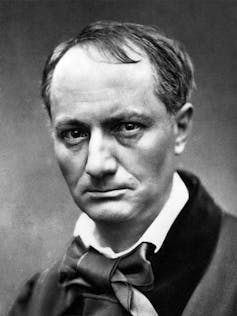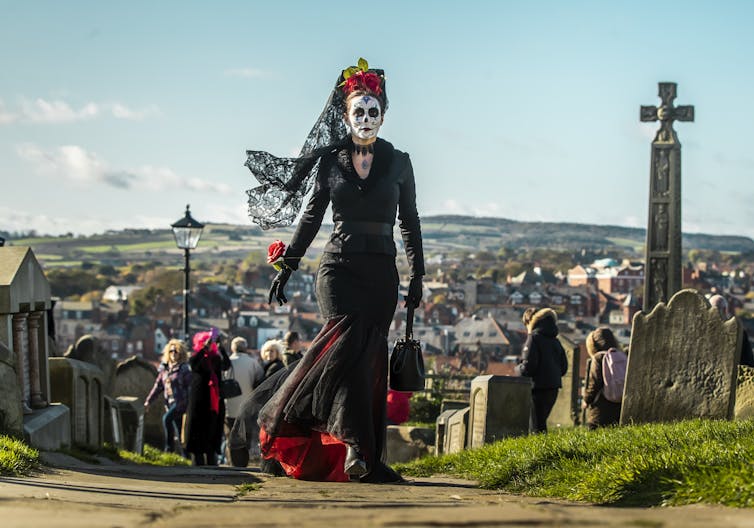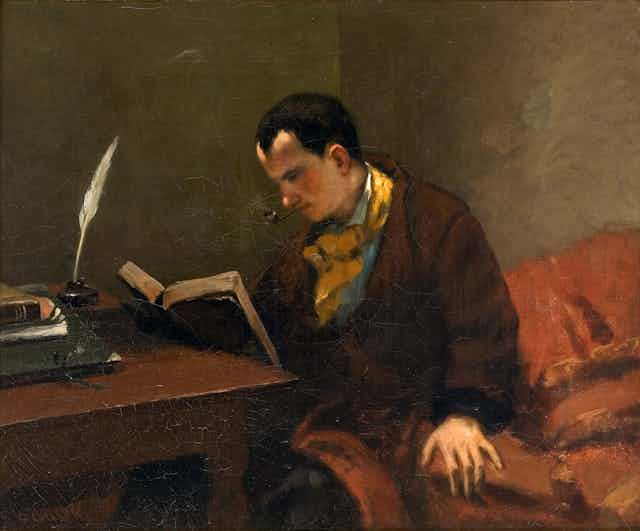Goths are typically regarded as being on the fringes of society – members of a subculture which finds beauty in the darker elements of human experience. And while their dress code is much imitated – and celebrated – over Halloween, they have a proud history that stretches far beyond a seasonal horror festival.
In fact, the French poet Charles Baudelaire (1821-67) could easily qualify as the template goths (and other bohemians) aspire to. He often dressed in black, dyed his hair green, and rebelled against the conformist, bourgeois world of mid-19th century Paris in both his personal life and his art.
His first collections of poems, Les Fleurs du Mal (The Flowers of Evil, 1857), was prosecuted for offending public morals, challenging its audiences with its startling treatments of sex, Satanism, vampirism and decay. No wonder his words would one day be set to music by The Cure.
Aside from his writing, Baudlaire’s dissolute life was a checklist of boho credentials. He fell out with his family. He went bankrupt. He pursued reckless sexual experiments and contracted syphilis. He developed a drug habit. He associated with artists, musicians, writers and petty criminals rather than “respectable” people.
He outraged his family by having a mistress who was mixed race and probably illiterate. He refused conventional employment and made a precarious living as a writer, critic and occasional art dealer.
He wrote poetry which was prosecuted for obscenity and was adored by like-minded souls throughout Europe while being hated, even feared, by “straight” society. And then he died young, after years of serious illness and addiction, at the age of 46.

Baudelaire was also a dandy, clean-shaven in an age of whiskers and dressed immaculately despite squalid domestic circumstances. Never ostentatious, he wore sombre black in mourning for his times.
Considering nature to be tyrannical, he championed everything which fought or transcended it, while being, like many of his contemporaries, overtly misogynistic. “Woman is natural. That is to say, abominable,” he wrote.
Nevertheless, he recognised how both genders were trapped within their fleshly prisons and urged resistance to such incarceration through costume and cosmetics, recreational sex, drugs and alcohol.
Baudelaire sounds like many later writers, actors and rock stars, but it is unfair to suggest his cultural importance resides only in his delinquent mannerisms. What makes Baudelaire so significant, and so relevant today, is his recognition in Les Fleurs du Mal, his prose poetry, and essays, that the urbanised, industrial and increasingly godless modern world is radically different from any earlier epoch.
Artists responding to these new conditions of existence cannot cling to outworn traditions. They need instead to cast off convention and rethink their relationship to their culture and surroundings.
Baudelaire’s translations of Edgar Allan Poe brought the American writer to a new audience – and the morbidity of many Baudelaire poems suggests the two men were kindred spirits. In Une Charogne (A Carcass, 1857) for example, he recounts finding a woman’s maggot-infested body, cataloguing her obscene decay in hideous detail before telling his lover that one day, she too will be rotten and worm-eaten.
Like his contemporary, Gustave Flaubert, Baudelaire felt stifled and alienated by the bombastic hypocrisy of Napoleon III’s Second Empire. He despaired at the gulf between public morality and private vice, and was sickened by the rise of bourgeois respectability, the protestant work ethic, and the sweeping modernisation of Paris itself.

Disdaining realism’s preoccupation with appearances, his writing examined the mental states his surroundings produced: boredom, an aggressive self-lacerating melancholy, and ennui – the listlessness and depression which left sufferers joyless and blasé.
He depicted himself as being like the king of a rainy country gripped by an unending despair, prematurely aged, impotent and sorrowful with no clear cause. “Life is a hospital,” he wrote, “in which all the patients are obsessed with changing their beds. One would prefer to suffer beside the fire, another thinks he’d recover sooner if placed by the window.”
A series of unfortunate events
More than 150 years after his death, Baudelaire remains a challenging figure – not least for his sexual attitudes. Nevertheless, his influence is undeniable. T.S. Eliot hailed him in The Waste Land (1922), borrowing his line: “Hypocrite lecteur – mon semblable – mon frère!” (Hypocrite reader, my likeness, my brother), for his dissection of the post-1918 world.
More recently, English author Angela Carter’s Black Venus (1985) gave a voice to Baudelaire’s mistress, Jeanne Duval, who rages at how “his eloquence denied her language”. And How Beautiful You Are, by Gothic rockers The Cure (1987) adapted his prose-poem Les Yeux des Pauvres (The Eyes of the Poor).
Baudelaire’s rich musical heritage is being currently documented by the Baudelaire Song Project. His notion of the “flaneur”, the aimless urban idler, influenced the German philosopher Walter Benjamin and the explorations of modern psychogeographers. His presence even lurks in the young adult fiction of Lemony Snicket, where the Baudelaire children suffer a series of unfortunate events.
Meanwhile, black remains one of the uniforms of teenage disaffection from London to Tokyo, shaping the subcultures of the past four decades. Baudelaire’s existential anxieties and refusal to capitulate to the forces of conformity make him a continued inspiration.

